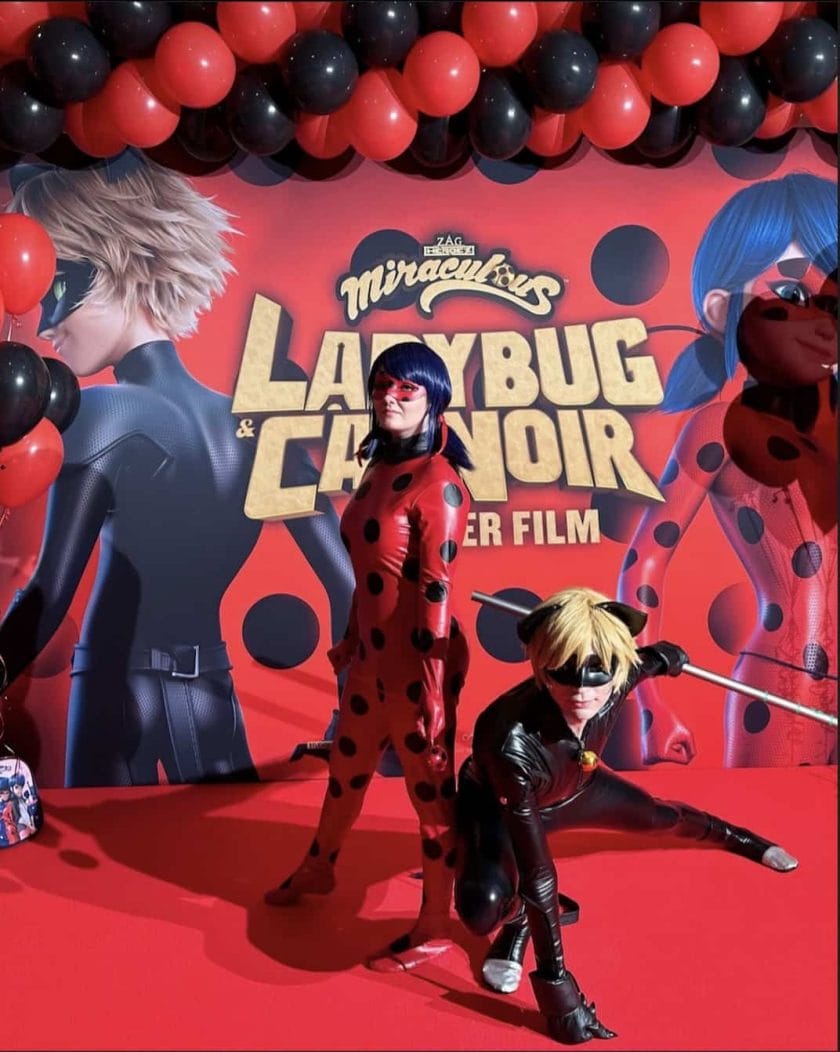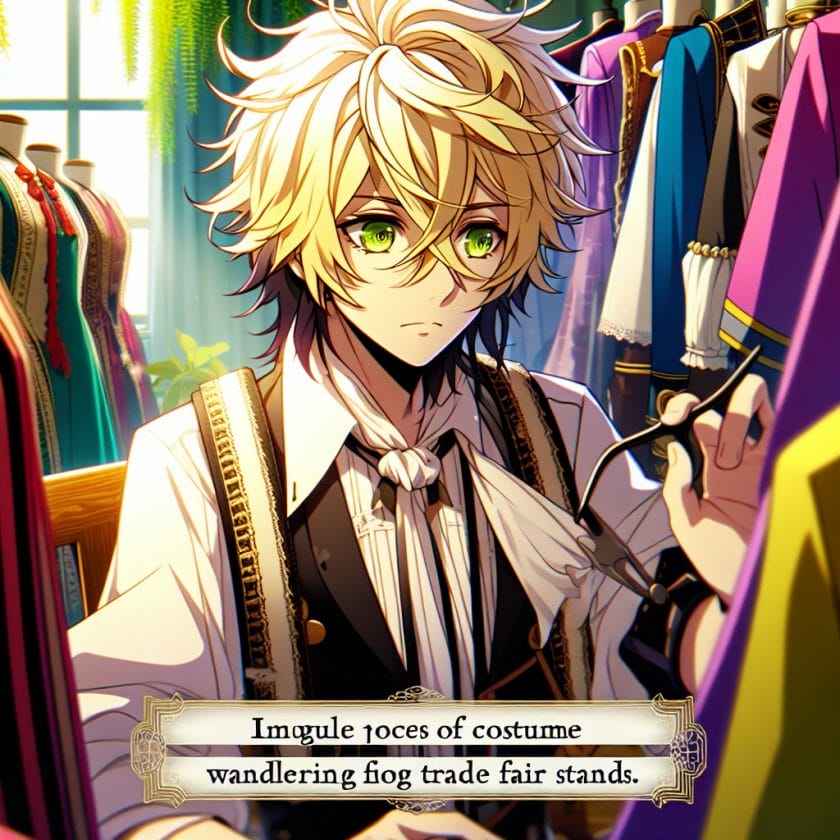[publishpress_authors_box layout="ppma_boxes_840322"]

1. What is the definition of a cosplayer?
A cosplayer is someone who engages in the practice of dressing up as a character from a work of fiction, such as a video game, anime, manga, or comic book. They meticulously recreate the appearance and mannerisms of their chosen character, often attending conventions or events where they can showcase their costumes and interact with other fans.
Being a cosplayer is like being an actor, but with more sewing involved. It’s all about bringing beloved characters to life and immersing oneself in the world of fandom. Cosplayers are passionate individuals who pour their hearts and souls into creating stunning costumes that pay homage to their favorite characters.
The Art of Transformation
Cosplay is not just about wearing a costume; it’s about embodying the essence of a character. Cosplayers go beyond simply putting on clothes; they study the character’s personality, gestures, and expressions to truly become them. It’s like stepping into another world for a brief moment and experiencing what it feels like to be someone else.
A Sense of Community
Cosplay has also created a vibrant community where like-minded individuals can come together and celebrate their shared love for fictional worlds. Conventions and events provide opportunities for cosplayers to connect with one another, exchange tips and tricks, and form lasting friendships. It’s incredible how cosplay can bring people from different backgrounds together through their mutual passion.
2. How did the concept of cosplay originate?
The concept of cosplay originated in Japan in the 1970s during the rise of science fiction conventions. The term “cosplay” itself is a combination of “costume” and “play,” highlighting the performative aspect of dressing up as fictional characters.
The Birth of Cosplay in Japan
In Japan, cosplay began as a subculture within the otaku community, which refers to people with obsessive interests in anime, manga, and video games. Fans started dressing up as their favorite characters to show their dedication and express their creativity.
Influence from Science Fiction Conventions
Japanese fans were inspired by the science fiction conventions held in the United States, where attendees would often dress up as characters from popular franchises. This practice resonated with Japanese fans, and they adopted it enthusiastically, taking it to new heights of craftsmanship and performance.
Spreading Across the Globe
With the advent of the internet and globalization, cosplay quickly spread beyond Japan’s borders. It gained popularity worldwide as more people discovered this unique form of self-expression. Today, cosplay is embraced by fans from all corners of the globe and has become an integral part of geek culture.
3. When did cosplay gain popularity and recognition as a hobby?
Cosplay gained significant popularity and recognition as a hobby in the late 20th century. The rise of conventions dedicated to comic books, anime, and gaming provided platforms for cosplayers to showcase their costumes and talents on a larger scale.
The Influence of Anime and Manga
Anime and manga played a crucial role in bringing cosplay into mainstream consciousness. As these forms of entertainment gained international popularity, so did the desire to emulate beloved characters through costume play.
The Impact of Comic-Con International
One event that played a pivotal role in elevating cosplay’s status was Comic-Con International, held annually in San Diego since 1970. Initially focused on comic books, it gradually expanded to include other aspects of popular culture like movies, TV shows, and video games. Cosplayers flocked to Comic-Con, turning it into a vibrant hub of creativity and self-expression.
The Rise of Social Media
With the advent of social media platforms like Instagram and TikTok, cosplay gained even more visibility and recognition. Cosplayers could now share their costumes with a global audience, gaining followers and building communities around their craft. This exposure helped solidify cosplay as a legitimate hobby and art form.
4. Who are some famous cosplayers known for their elaborate costumes and performances?
Famous Cosplayers
Some famous cosplayers have gained widespread recognition for their exceptional craftsmanship and performances. One notable example is Yaya Han, a veteran cosplayer who has been active in the community for over two decades. Known for her intricate and detailed costumes, Yaya Han has become an influential figure in the cosplay world. Another renowned cosplayer is Jessica Nigri, who gained popularity through her stunning portrayals of various characters and her engaging presence at conventions.
Yaya Han
Yaya Han’s expertise in costume design and construction has earned her numerous awards at cosplay competitions. She often shares her knowledge through tutorials and workshops, inspiring aspiring cosplayers to improve their skills. With a strong online following, Yaya Han continues to be a prominent figurehead in the cosplay community.
Jessica Nigri
Jessica Nigri rose to fame after her portrayal of a sexy Pikachu cosplay went viral. Since then, she has built a successful career as both a professional cosplayer and a model. Her charismatic personality and dedication to bringing characters to life have made her one of the most recognizable faces in the cosplay world.
Other notable cosplayers include Kamui Cosplay, known for her expertise in armor-making, and Stella Chuu, who specializes in creating elaborate costumes with unique twists.
5. Can you explain the process of creating a cosplay costume from scratch?
Creating a cosplay costume from scratch involves several steps that require creativity, skill, and attention to detail.
The Process of Creating a Cosplay Costume
1. Character Research: The first step is researching the character you want to portray. This includes studying their appearance, personality traits, and any distinguishing features.
2. Design and Planning: Once you have a clear understanding of the character, you can start designing your costume. This involves sketching out ideas, deciding on materials, and planning the construction process.
3. Material Selection: Choosing the right materials is crucial for bringing your cosplay to life. Commonly used materials include fabrics, foam, thermoplastics like Worbla or EVA foam, and various types of adhesives.
4. Pattern Making: Creating patterns allows you to cut and shape the fabric or other materials accurately. This step involves measuring yourself or using pre-existing patterns as a base.
5. Construction: With the patterns ready, it’s time to start sewing or assembling the costume pieces. This may involve techniques such as sewing, gluing, heat shaping, and painting.
6. Detailing and Accessories: Adding details like buttons, trims, or embellishments enhances the overall look of the costume. Additionally, creating accessories such as props or wigs can further elevate your portrayal of the character.
7. Fitting and Adjustments: Trying on the costume throughout the construction process is essential to ensure a proper fit. Make any necessary adjustments to ensure comfort and accuracy.
8. Finishing Touches: Finally, give attention to small details like ironing seams, adding final touches with makeup or body paint if needed, and making sure everything is secure before wearing the cosplay.
Remember that creating a cosplay costume from scratch requires patience and practice. It’s important to enjoy the process and be open to learning new techniques along the way.
6. What are some common materials used in cosplay costume construction?
Common Materials in Cosplay Costume Construction
Cosplayers use a wide range of materials when constructing their costumes depending on their desired level of detail and durability.
– Fabrics: Common fabrics include cotton, polyester blends, spandex for bodysuits or tight-fitting garments, and faux leather for replicating armor or accessories. Specialty fabrics like satin or silk may be used for more elegant costumes.
– Foam: EVA foam and craft foam are popular choices for creating armor, props, and intricate details. They can be easily shaped, heat-formed, and painted to achieve realistic effects.
– Thermoplastics: Materials like Worbla or Sintra are thermoplastic sheets that can be heated and molded into various shapes. They are commonly used for creating armor pieces due to their durability and flexibility.
– Adhesives: Cosplayers use different types of adhesives depending on the materials being bonded together. Hot glue guns, fabric glue, contact cement, or epoxy resin are commonly used for securing various components.
– Worbla’s Black Art: This variant of Worbla is a thermoplastic with a black surface layer that eliminates the need for priming or painting. It is often used when a smooth black finish is desired.
– Worbla’s TranspArt: This transparent thermoplastic allows cosplayers to create clear or translucent elements such as gems or visors.
– Worbla’s Meshed Art: This variant of Worbla has an embedded mesh that provides added strength while still being moldable. It is commonly used for large armor pieces.
These are just a few examples of the many materials available to cosplayers. The choice of materials depends on the specific requirements of each costume and personal preferences in terms of appearance and ease of use.
7. Are there any specific skills or talents required to become a successful cosplayer?
7.1 Sewing and Costume Making
To create accurate and detailed costumes, cosplayers often need to possess sewing and costume making skills. This includes knowledge of different fabrics, patterns, and techniques for constructing garments. Many cosplayers invest time in learning how to use a sewing machine and acquiring basic tailoring skills.
7.2 Makeup Artistry
Another important skill for cosplayers is makeup artistry. Cosplayers often transform their appearance to match the characters they portray, which requires knowledge of contouring, shading, and special effects makeup techniques. They may also need to learn how to apply prosthetics or create realistic wounds or scars using special FX makeup.
7.3 Prop Building
Creating props is another skill that can greatly enhance a cosplay. Many characters carry unique weapons or accessories that need to be accurately replicated. Cosplayers with prop building skills can work with materials like foam, thermoplastics, and resin to create intricate and realistic props.
List of Skills:
- Sewing and costume making
- Makeup artistry
- Prop building
- Wig styling
- Photography and posing
- Performance and acting
- Craftsmanship (working with materials like worbla or EVA foam)
- Knowledge of character source material (anime, video games, etc.)
8. How do cosplayers choose which characters to portray?
Cosplayers have various methods for choosing the characters they want to portray:
8.1 Personal Connection or Favorite Characters:
Many cosplayers choose characters that they have a personal connection with or characters that they simply love. They may be fans of a particular anime, video game, or comic book series and want to bring their favorite characters to life.
8.2 Visual Appeal:
Some cosplayers are drawn to characters based on their visual appeal. They may be attracted to unique costume designs, intricate armor, or eye-catching props. Cosplayers enjoy the challenge of recreating visually stunning characters.
8.3 Group Cosplays:
Group cosplays involve multiple cosplayers dressing up as characters from the same series or theme. Cosplayers may choose characters that fit within a group cosplay idea suggested by friends or fellow cosplayers.
List of Methods for Choosing Characters:
- Personal connection or favorite characters
- Visual appeal
- Group cosplays
- Challenges (complex costumes, props, or makeup)
- Cultural significance
- Nostalgia (cosplaying childhood heroes)
- Trends (popular characters at the time)
(Note: The methods for choosing characters can vary greatly among individual cosplayers and are not limited to these examples.)
9. What are some popular events or conventions where cosplayers gather and showcase their costumes?
Cosplay has become an integral part of many pop culture events and conventions worldwide. Some popular events where cosplayers gather and showcase their costumes include:
9.1 Comic-Con International:
Comic-Con International is one of the largest pop culture conventions in the world, taking place annually in San Diego, California. It attracts a massive number of cosplayers who showcase their costumes inspired by various genres like comics, movies, TV shows, and video games.
9.2 Anime Expo:
Anime Expo is the largest anime convention in North America, held annually in Los Angeles, California. It brings together cosplayers who specialize in portraying characters from Japanese animation and manga.
9.3 Dragon Con:
Dragon Con is a multi-genre convention held in Atlanta, Georgia. It features a significant cosplay presence and attracts cosplayers from various fandoms, including sci-fi, fantasy, gaming, and more.
9.4 Cosplay Events at Local Comic Shops:
Many local comic shops organize events specifically for cosplayers to showcase their costumes. These events provide a more intimate setting for cosplayers to connect with fellow enthusiasts and share their passion for cosplay.
List of Popular Events:
- Comic-Con International
- Anime Expo
- Dragon Con
- New York Comic Con
- PAX (Penny Arcade Expo)
- San Diego Comic Fest
- EuroCosplay Championships (Europe)
- World Cosplay Summit (Japan)
(Note: The popularity of events may vary depending on location and personal interests.)
10. Do cosplayers always dress up as fictional characters, or can they also portray real-life individuals or historical figures?
Cosplayers are not limited to dressing up as fictional characters; they can also portray real-life individuals or historical figures. This aspect of cosplay is known as historical or celebrity cosplay. In historical cosplay, cosplayers recreate the attire and appearance of famous figures from different time periods, such as Marie Antoinette or Cleopatra. They meticulously research the clothing styles, accessories, and cultural context to accurately represent these individuals.
Similarly, celebrity cosplay involves cosplaying as real-life famous personalities like actors, musicians, or politicians. Cosplayers may choose to imitate their favorite celebrities by replicating their iconic outfits from movies, red carpet events, or music videos. This type of cosplay allows fans to pay tribute to their idols and showcase their admiration for them.
Dressing Up as Historical Figures
When cosplaying historical figures, attention to detail is crucial. Cosplayers often join specific communities dedicated to historical reenactment and accuracy. They research extensively about the figure they want to portray learning about their lives, achievements, and the fashion trends prevalent during that era. By recreating historically accurate costumes and accessories, cosplayers bring these significant individuals back to life at conventions or themed events.
Examples of Historical Cosplay
1. Civil War Reenactment: Many cosplayers participate in events commemorating the American Civil War by dressing up as soldiers from that era.
2. Renaissance Fairs: These popular events provide an opportunity for cosplayers to showcase elaborate costumes inspired by medieval times.
3. Ancient Egyptian Cosplay: Fans of ancient history often create stunning replicas of pharaohs’ attire and jewelry.
In summary, while fictional characters remain a prominent focus in cosplay culture, there is also ample room for cosplayers to explore and celebrate real-life individuals and historical figures through their craft.
11. How has social media influenced the world of cosplay, and how do cosplayers use platforms like Instagram and TikTok to connect with fans?
The rise of social media has had a profound impact on the world of cosplay, allowing cosplayers to reach a wider audience and connect with fans in unique ways. Platforms like Instagram and TikTok have become essential tools for cosplayers to showcase their work, share their creative process, and engage with fellow enthusiasts.
The Power of Instagram
Instagram is a popular platform among cosplayers due to its visual nature. Cosplayers can curate a feed filled with high-quality photos showcasing their costumes, makeup, and props. They often collaborate with photographers or utilize self-timer techniques to capture stunning shots that highlight the intricate details of their cosplay. By using relevant hashtags, such as #cosplay or #cosplaycommunity, they can attract followers who share similar interests.
Connecting with Fans on TikTok
TikTok has emerged as another influential platform for cosplayers. Its short-form video format allows them to create engaging content that showcases their costumes in action or demonstrates their transformation process. Cosplayers often participate in trending challenges or duets with other creators to gain visibility within the larger TikTok community. This platform enables them to connect directly with fans through comments, live streams, or even collaborations.
Furthermore, both Instagram and TikTok provide opportunities for cosplayers to interact with fellow enthusiasts by joining cosplay-related groups or participating in virtual conventions. These platforms have democratized access to cosplay content, allowing fans from all over the world to discover and appreciate the creativity of cosplayers.
In conclusion, social media platforms like Instagram and TikTok have revolutionized how cosplayers share their passion with the world. They provide avenues for greater visibility, community engagement, and creative expression within the cosplay community.
(Note: The next three subheadings will be expanded in subsequent responses.)
12. Are there any ethical considerations in cosplay, such as cultural appropriation or copyright infringement?
Cultural Appropriation
Cultural appropriation is a significant ethical consideration in the world of cosplay. It refers to the adoption or use of elements from a different culture without understanding or respecting its significance. Cosplayers often portray characters from various cultures, and it is essential to approach this with sensitivity and respect. It is crucial to research and understand the cultural context of the character being portrayed and avoid perpetuating stereotypes or disrespecting traditions.
Copyright Infringement
Another ethical concern in cosplay is copyright infringement. Many cosplayers recreate costumes based on characters from movies, TV shows, video games, or comics. While it is generally accepted for individuals to create costumes for personal use, selling or profiting from these costumes can infringe upon copyright laws. It is important for cosplayers to be aware of intellectual property rights and seek permission when necessary.
Lists:
– Research and educate yourself about the cultural background of the character you are cosplaying.
– Avoid using elements that may perpetuate stereotypes or disrespect a particular culture.
– Seek permission when creating and selling costumes based on copyrighted characters.
– Be mindful of intellectual property rights and respect creators’ work.
13. Can you explain the difference between casual cosplay and professional cosplay?
Casual cosplay refers to individuals who engage in dressing up as their favorite characters for fun, enjoyment, and personal expression. It usually involves creating costumes using readily available materials, focusing more on capturing the essence of the character rather than achieving perfect accuracy. Casual cosplayers often participate in conventions or events as a hobbyist without seeking monetary compensation.
On the other hand, professional cosplay involves individuals who have turned their passion into a career. These cosplayers often invest significant time, effort, and resources into creating highly detailed and accurate costumes. They may compete in cosplay competitions, work as cosplay models or influencers, and even earn income through commissioned costume creations. Professional cosplayers often have a substantial online presence and may travel to conventions worldwide.
Lists:
– Casual cosplay is primarily done for personal enjoyment, while professional cosplay involves making a career out of it.
– Casual cosplayers focus on capturing the essence of the character rather than achieving perfect accuracy.
– Professional cosplayers invest more time, effort, and resources into creating highly detailed and accurate costumes.
– Professional cosplayers may earn income through various avenues related to cosplay.
14. Have there been any significant controversies or debates within the cosplay community?
The cosplay community has experienced several controversies and debates over the years. One such controversy revolves around “cosplay is not consent,” which addresses issues of harassment and consent at conventions. This movement aims to raise awareness about respecting boundaries and consent when interacting with cosplayers.
Another debated topic is “cosplay accuracy” versus “cosplay body positivity.” Some argue that cosplay should focus on accurately representing characters’ physical attributes, while others advocate for body positivity and inclusivity, encouraging individuals of all body types to participate in cosplay without feeling pressured to conform to certain standards.
Furthermore, cultural appropriation within cosplay has sparked discussions about respecting different cultures and avoiding stereotypes. It has prompted conversations about appropriate representation and understanding the significance behind the characters being portrayed.
Lists:
– The “cosplay is not consent” movement emphasizes the importance of consent and respect for cosplayers’ boundaries.
– Debates exist between those who prioritize accuracy in portraying characters’ physical attributes versus promoting body positivity and inclusivity.
– Discussions surrounding cultural appropriation have led to conversations about appropriate representation in cosplay.
In conclusion, a cosplayer is someone who brings their favorite characters to life through creative costumes and performances. It’s a fantastic way to express your love for a particular fandom and immerse yourself in the world of fiction. So, if you’re interested in joining this amazing community or need assistance with your cosplay endeavors, be sure to check out our cosplay services! We’d be thrilled to help you turn your imagination into reality. Let the adventures begin!
https://images-wixmp-ed30a86b8c4ca887773594c2.wixmp.com/f/6c0300ba-052a-44f0-ab0b-c2c2fca43225/d67g8gt-d87174fe-5030-4704-8338-a7457bf59194.jpg/v1/fill/w_900,h_630,q_75,strp/cosplay_evolution_by_samhainkwc_d67g8gt-fullview.jpg?token=eyJ0eXAiOiJKV1QiLCJhbGciOiJIUzI1NiJ9.eyJzdWIiOiJ1cm46YXBwOjdlMGQxODg5ODIyNjQzNzNhNWYwZDQxNWVhMGQyNmUwIiwiaXNzIjoidXJuOmFwcDo3ZTBkMTg4OTgyMjY0MzczYTVmMGQ0MTVlYTBkMjZlMCIsIm9iaiI6W1t7ImhlaWdodCI6Ijw9NjMwIiwicGF0aCI6IlwvZlwvNmMwMzAwYmEtMDUyYS00NGYwLWFiMGItYzJjMmZjYTQzMjI1XC9kNjdnOGd0LWQ4NzE3NGZlLTUwMzAtNDcwNC04MzM4LWE3NDU3YmY1OTE5NC5qcGciLCJ3aWR0aCI6Ijw9OTAwIn1dXSwiYXVkIjpbInVybjpzZXJ2aWNlOmltYWdlLm9wZXJhdGlvbnMiXX0.HzHEfE7cISv1GsBhA-rxL9DelgyUScW-Sh2QOS14CQk








